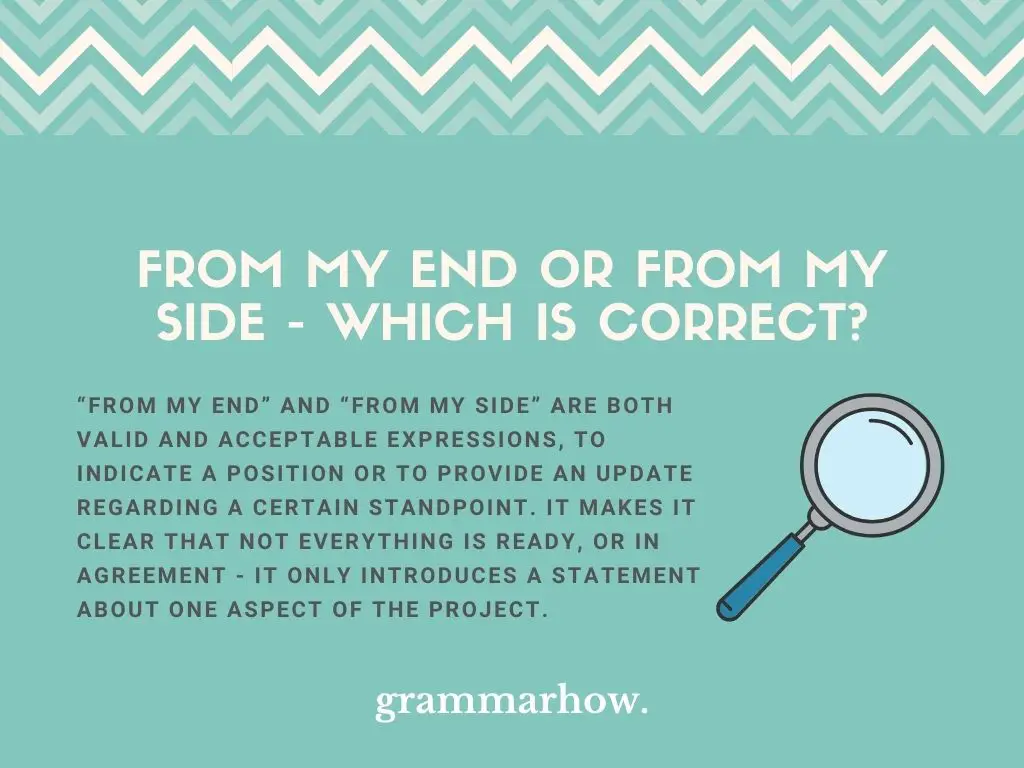When working as a team, how can you communicate that your part of the job is done? Some people say, “From My End” and others say “From My Side”.
We wonder if both phrases are correct. We also wonder if those are appropriate terms for a professional environment.
From My End or From My Side – Which Is Correct?
“From My End” and “From My Side” are both valid and acceptable expressions, to indicate a position or to provide an update regarding a certain standpoint. It makes it clear that not everything is ready, or in agreement – it only introduces a statement about one aspect of the project.

Take a look at the examples below:
- From my end, there’s nothing left to do.
- From my side, there’s nothing left to do.
- Clay complained about the delays, but from my end, we’re on schedule.
- Clay complained about the delays, but from my side, we’re on schedule.
Both sets of examples show the same sentence, only interchanging the phrases “From My End” and “From My Side”. As you probably noticed, they convey the exact same message, indicating that those expressions can interchange.
Which one is your favorite to use?
What Does “From My End” Mean?
“From My End” is an expression that described how one aspect of a project is going. It’s not about the whole, but only about what that individual is involved in. It’s very common in professional environments.
When someone says “From My End”, they’re making it clear that the information provided reflects only what they can see or state on their side, and not an overall picture.
Take a look at the examples below:
- I can’t see the output from my end.
- All the work is complete from my end.
- How much work is left on your end?
- Everything looks good from my end.
- I don’t have much work done from my end.
“From My End” is common expression in professional environments, where many people are working on the same thing and have to report to the team (or update them) on what’s going on with the job they’re performing.
It makes it clear that the individual isn’t speaking for the whole job or project, but specifically about the part he’s involved in.
What Does “From My Side” Mean?
“From My Side” conveys the same message as “From My End”, only using a different word. When someone reports an update using “From My Side”, they make it clear that they aren’t speaking for the whole group, but only for the work that they’re performing.
Take a look at some examples that show “From My Side” in use:
- From my side, the program isn’t loading.
- Is the work completed from your side?
- There’s not much left to do from my side.
- Everything is set from my side.
- When I finish from my side I’ll let you know.
“From My Side” and “From My End” mean exactly the same thing. You can choose the one you prefer and add it to your office jargon portfolio.
Which Is Used the Most?
Which one of those forms is used more often, “From My End” or “From My Side”? Let’s take a look at the graph from Google Ngram Viewer below to find out.

“From My Side” seems to be used more often than “From My End”. But it’s also interesting to notice that both phrases have increased in use since the 2000s, indicating that it has started trending as office jargon fairly recently.
Why people would prefer “From My Side” over “From My End”, isn’t something we can guess. You should keep in mind, however, that both forms are grammatically correct and you can choose to use the one you feel more comfortable with.
Final Thoughts
Both “From My End” and “From My Side” convey the meaning that, within the scope of a project, an individual is reporting what’s happening on the part they’re involved in (and not the whole job). Both are correct, so you can use the one you prefer in your professional communications.

Martin holds a Master’s degree in Finance and International Business. He has six years of experience in professional communication with clients, executives, and colleagues. Furthermore, he has teaching experience from Aarhus University. Martin has been featured as an expert in communication and teaching on Forbes and Shopify. Read more about Martin here.
